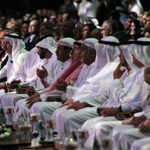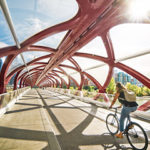Few major global events manage to escape criticism. But Expo Milano 2015 — the six-month-long world’s fair on all things food taking place in Milan through Oct. 31 — has experienced a plague of controversies. And with headlines about violent protests, organized crime, and major delays, they aren’t exactly minor.
On May 1, the Expo’s opening day, No Expo — an organization protesting the event — organized a crowd of 30,000 people to march through the streets of Milan. Masked demonstrators, who No Expo say were not part of their organization, turned violent, smashing storefronts, throwing fire bombs, destroying dozens of cars, and leaving a number of police officers wounded.
No Expo and other groups had criticized the event since before Milan won the bid in 2008, voicing concerns about everything from the potential financial burden on Italy to possible negative environmental effects. In 2014, seven officials associated with the Expo were arrested on corruption charges, which included bid rigging, according to Reuters. Many have also openly criticized the Expo for not staying true to the event’s theme — “Feeding the Planet, Energy for Life.” They include Jacques Herzog of Herzog & de Meuron, the architecture firm originally tasked with designing the Expo’s master plan. According to Herzog, his company left the project in 2011 when Expo organizers and participating countries wouldn’t commit to the firm’s simplistic design — one that aimed to do away with the grandiose country pavilions typical of world’s fairs.
“There is an amazing variety of global themes that should be tackled and brought to the fore — the conventional format, with national pavilions competing for design awards, cannot deliver that!” Herzog told Uncube magazine. “We felt this expo would be exactly the right place to start focusing on content, because it simply seems embarrassing to address this very important topic and at the same time build enormous, dramatically curved pavilions with facades in wavy plastic or dramatic waterfalls or whatever. We would much rather know how countries like Kenya, Mexico, China, Laos, or Germany are dealing with the question of how to feed their people.”
And then there are Italy’s economic issues. In late 2015, Italy is just beginning to come out of its longest-ever post–World War II recession, and according to news reports, the Expo is costing the debt-ridden country billions of euros for infrastructure improvements. But government officials are hopeful the impact of attracting an estimated 20 million visitors will be worth the investment as well as help reestablish the country’s global standing as a place to do and bring business. According to news reports, Expo officials estimate the event will increase Italy’s GDP by up to $15 billion, have an economic impact of $10.7 billion on Milan, and create close to 200,000 jobs. According to Expo officials, as of the end of July, 15.6 million tickets had been sold, and the entrance turnstiles registered 6.1 million entrances.
FEEDING THE PLANET, ENERGY FOR LIFE
This past June, Convene headed to Milan to experience the Expo firsthand. Walking into the Expo feels a bit like walking into Disney World — there’s an overwhelming sensation of needing to see absolutely everything, now, and not knowing where to start. Straddling the Expo’s two main avenues are the pavilions of more than 140 countries and dozens of other food-related businesses and organizations. Narrowing down what to see is not easy — especially if you only have a day or two. There’s the Italian wine pavilion’s library of 1,400 bottles on tap, the United Kingdom’s much-buzzed-about beehive-inspired pavilion, and the striking United Arab Emirates Pavilion, whose 40-foot walled exterior mimics undulating sand dunes.
Brazil’s pavilion houses a netted structure that visitors can climb on like a giant jungle gym, and Russia’s massive mirrored entrance draws selfie-takers like a magnet. The Netherlands, which gets my vote for quirkiest exhibit, scrapped the pavilion model in favor of a smattering of circus-themed attractions, including a mini Ferris wheel, a DJ, and a fleet of food trucks selling waffles and beer.
Expo Milano is the first world’s fair to take on the theme of food, and more specifically, how the world as a collective whole can solve the problems that come with feeding a population that will surpass 9 billion in 2050. There is the contradictory challenge of solving both obesity and hunger even as issues like food waste, sustainable farming, and public policy are demanding more attention. As I weaved in and out of pavilions, grazing and drinking around the world, I thought, This is really fun. But I wondered: Is this expo getting anyone here to actually think about these issues?
READY FOR A SLOWDOWN
At the very end of Decumano, the mile-long main avenue running east to west through the Expo, I found the bucolic Slow Food pavilion. The triangular campus is made up of three open-air, rectangular buildings housing a theater, an exhibit space, and a tasting bar. In the center of the three buildings is a 2,690-square-foot garden of live plants and produce native to the Lombardy region. Designed by Herzog & de Meuron, the farmhouse-inspired structures can be easily broken down for repurposing elsewhere. “It’s a surprisingly austere, low-tech, breezy monument to agricultural traditions,” said Richard McCarthy, executive director of Slow Food USA, which had a presence at the pavilion as part of Slow Food, an independent international nonprofit organization with chapters in more than 150 countries.
From Oct. 3–6, Slow Food will hold its “Terra Madre Youth — We Feed the Planet” event in Milan, bringing together young farmers, food artisans, fishers, chefs, and activists from around the world to discuss the future of food and farming, among other activities. In a way, the event will serve as a comment about what Slow Food believes the Expo should really be about. Leading up to the opening, Slow Food made headlines about its clashes with event organizers on multiple points, from the presence of companies like McDonald’s to the lack of representation of farmers.
“There was a lot of internal soul searching as to, if we do not fully endorse the way that the Expo ultimately presents itself, in product,” McCarthy said. “If we’re there, we’re endorsing it by being there. There’s a sense that there is sort of a soulessness to the Expo, and it’s appalling that the only people not there are farmers.”
Within Slow Food’s exhibition, installations make another clear statement about the organization’s mission and what visitors should be thinking about when it comes to food production. For example, A World of Corn — a bloated, corn-covered statue of a sitting human — comments on how the once fundamental diet staple has morphed into unhealthy modified forms, such as high-fructose corn syrup, hidden in everyday foods.
But there’s fun stuff, too. The pavilion sells a tastings gift set with different varieties of cheese and wine from nearby producers in Italy, to go along with its biodiversity theme. “A lot of thought went into the cheese and wine being in line with Slow Food values,” McCarthy said.
AN AMERICAN IN MILAN
Called “American Food 2.0, United to Feed the Planet,” the USA Pavilion is immediately recognizable. A giant, Jasper Johns-esque flag installation (a fork, a plate, and a knife replace the stars) juts out on one side to signal the entrance, and on the other side of the exterior is a vertical farm measuring 9,250 square feet — the length of a football field — growing more than 40 varieties of harvestable grains, vegetables, and herbs.
Visitors enter the pavilion via a boardwalk, constructed with wood from the Coney Island Boardwalk. On the pavilion’s website, its architect, James Biber of New York City–based Biber Architects, explains that he designed the 42,000-square-foot, multilevel space to feel like a promenade. The intent is for visitors to leisurely explore the agricultural legacy of different regions and interact with exhibits about American policy, cooking, farming, and other food-related topics.
The exhibition physically stretches beyond the pavilion. Around the corner, Food Truck Nation sells American classics like Black Angus beef burgers and barbecue, and in downtown Milan, the pop-up James Beard American Restaurant at Seven Stars Galleria is hosting a rotation of visiting American chefs for the Expo’s duration. As of June 25, the USA Pavilion had reported 1 million visitors.
“We’re trying to be as dynamic and engaging as we can while we’re here, because it’s one thing to have a fun building, but we want to make sure we have an impact,” said James Mitchell, executive vice president of the James Beard Foundation and chief creative officer of the USA Pavilion.
Mitchell has been at the helm of the project from the very beginning, starting back in 2013 when he was approached to organize a proposal for the USA Pavilion, as well as find funding. The United States is unique in that it is not a member of the Paris-based Bureau of International Expositions, the governing body of world’s fairs (Congress withdrew funding for participation in 2001); as a result, the country could participate, but only if privately funded. Mitchell is also responsible for filling the calendar with events and special projects associated with the Milan Expo, either at the pavilion or at the James Beard restaurant in Milan — including one addressing the responsibility the entertainment industry has in educating the public about food and nutrition.
“We’re just trying to make this whole thing come alive,” Mitchell said, “not just for these six months, but to create a legacy for an American institution here in Italy and Europe and beyond.”
THE BIGGER QUESTION
Mitchell said he wants people who visit the USA Pavilion to leave having “one extra thought about what you had for breakfast or dinner. Then I think we have a success, to make someone more mindful of food.” At the same time, Mitchell was mindful that “one of the challenges of this project, for every country,” is “to provide what people might come expecting. For example, all of the Italians who come to the Expo only know two things about America: hamburgers and Obama. You can’t not have them. You can’t go too far away from what people expect to find.”
As for the Expo’s legacy to Milan — positive and lasting, or merely an expensive undertaking — McCarthy acknowledged that is “a very serious question.” He added: “As a serious gathering that attracts significant public funding, that wants to be taken seriously in playing a role with global public policy around food — is [the Expo] going to succeed on that front? No, probably not.
“I don’t think that this is a venue that lends itself to … state leaders and elected officials making their mark, making strong statements that will shift our public policy,” Mitchell said. “I think it’s in the soft space of general consumers becoming more knowledgeable about food issues, largely about the global contours of food, and beginning to elevate food as a legitimate issue to not only attract but maintain our attention over the long haul.”




